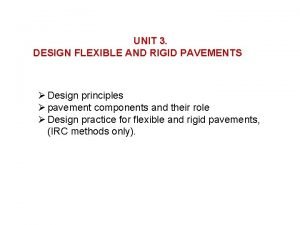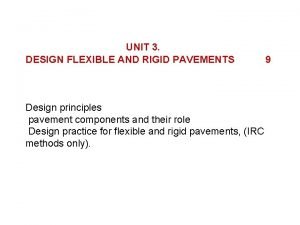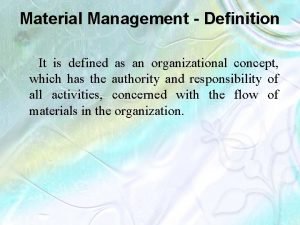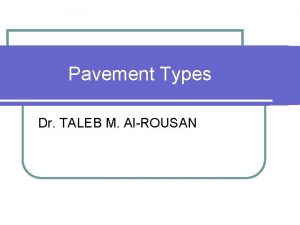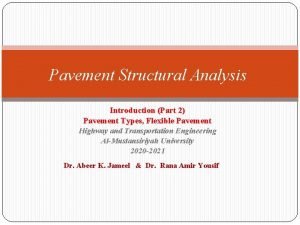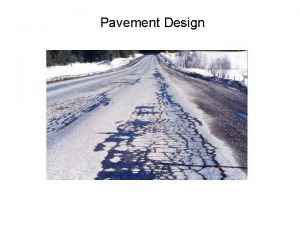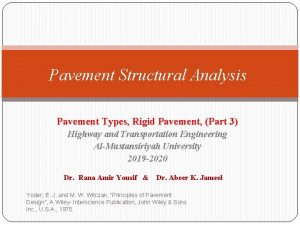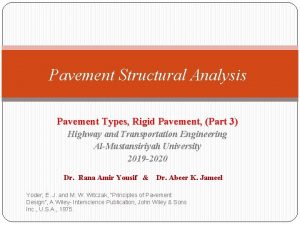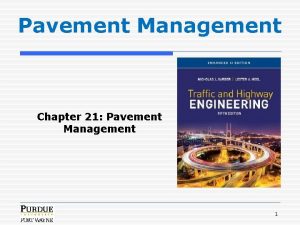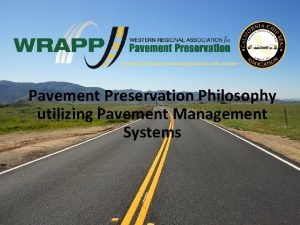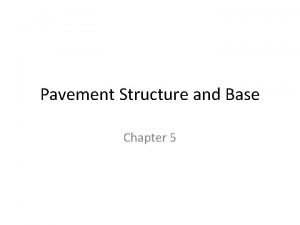Pavement Management 1 Pavement Management defined Pavement Management















- Slides: 15

Pavement Management 1

Pavement Management defined: Pavement Management is a systematic process of maintaining, upgrading and operating a network of pavements to optimize safe, smooth and economic pavement conditions over an entire network within an agencies budgetary constraints. Success in pavement management is accomplished by maintaining pavements in a good or better condition while maximizing their life cycle. This can be achieved by monitoring a pavement’s condition over time by means of a data collection and rating procedure combined with effective utilization of a pavement management system to optimize strategic application of pavement preservation treatments. 2

Pavement Management (continued) Pavement Management – State Aid supports and encourages the adoption and implementation of local agency pavement management programs and plans. To assist agencies in implementing pavement management programs, State Aid provides technical assistance, resources and tools. 3

Pavement Management (continued) Pavement Management Plan defined: A pavement management plan involves adopting a strategy of activities that monitor pavement conditions and prioritize maintenance, preservation and construction activities with available funding to optimize the conditions of a roadway network. An effective pavement management plan assists transportation agencies to optimize their available funding, better communicate funding needs, and more objectively manage the overall pavement network. 4

Pavement Management (continued) • Pavement management plan key components • System condition assessment and performance monitoring (pavement data collection, analysis and review) • Effective pavement preservation practices • Agency goals and policies • Public education and engagement 5

Pavement Management (continued) System Condition Assessment & Performance Monitoring Assessing and monitoring pavement conditions at a network level is key to effective pavement management. In 2005, Minnesota County Engineers purchased a Pathway Services automated digital inspection van (DIV). This was the beginning of their monitoring the condition of the 25, 000 plus miles of the paved County State Aid Highway (CSAH) system under their management. The Mn. DOT Pavement Management Division assists the Counties in this effort. Since 2005, the CSAH system has been monitored on a four year cycle. Beginning in 2017, a second Pathway van was purchased and monitoring was increased to a two year cycle. 6

Pavement Management (continued) Data Collection • A specialized Digital Inspection Van (DIV) is used for roadway data collection. Pathway Services, Inc. of Tulsa Oklahoma developed and builds these vans. • Pathway DIV’s are used to collect pavement condition data (roughness and surface distress) on the CSAH system. Currently data is collected with two DIV’s using two cameras, a scanning laser, 3 D laser/camera and laser height sensors. Pavement rutting, distress (cracking type, severity and amount) and roughness are determined. • The paved portion (≈25, 500 miles) of the CSAH system is surveyed on a two year cycle. • Counties can elect to pay and have their local paved County Road system also surveyed. • Video log data is gathered and provides counties visual documentation of their roadway condition. (Digital Inspection Van) 7

Pavement Management (continued) (Forward and right shoulder view) Data Collection • Roadway imaging provide two views of the roadway; a forward view of the road lane being surveyed and the right shoulder area documenting road-side conditions and appurtenances (vegetation, curbs, guardrail, signs, etc. ). Digital images are collected every 26. 5 feet at typical traveling speed up to 70 mph. Images are synchronized with the sensors and location data. An individual can virtually view any surveyed road on their computer monitor. (3 D imaging) • The DIV’s are equipped with a 3 D data acquisition system which collects highresolution images and transverse profiles of the roadway. The technology allows mapping the elevation differences of the road surface providing the ability to view cracking and rutting in the pavement. • International roughness (IRI) of the pavement surface is gathered using an Inertial Road Profiler. Ride Number and Ride Quality Index (RQI) are also calculated. 8

Pavement Management (continued) Data Analysis • Path. View II is the software developed by Pathway. It analyzes data collected by the DIV. Other features include the ability to import and export data from other applications, photo surface distance measuring, custom reporting of data among other options. • Video Log – High resolution images capture a visual record of the road network surveyed. An individual can virtually view any roadway surveyed. • Automated Crack Detection – Beginning in 2017, all roadways surveyed will utilize this option allowing 100 percent rating of the roadways surveyed. Prior to 2017 the first 500 feet of each mile (10 percent) was manually rated. • Data Reporting – Customized data reporting is available to provide simple and accurate reporting of data. • Asset Inventory – the high resolution imaging can be used to asses signage, pavement markings, bridge decks, structures, guardrail, etc. Customized asset inventory of any items of interest can be performed. 9

Pavement Management (continued) Data Review • Data is reduced to several indices for reporting. It assists the counties in understanding their pavement system condition. • Ride Quality Index - RQI (scale = 0. 0 - 5. 0) • Surface Rating - SR (scale = 0. 0 - 4. 0) • Pavement Quality Index - PQI (scale = 0. 0 - 4. 5) = √(( ������ )�� (���� )) • Remaining Service Life - RSL (reported in years) • Note: descriptions of these indices and additional supporting data can be found in the Mn. DOT Pavement Condition Annual Report. • Counties use this data in multiple ways. • Use data as provided (no manipulation or filtering) • Analyze the data further with a home grown analysis spread sheet or tool. (Digital Image Workstation) • Upload into a Pavement Management System software tool which develop pavement performance curves. These curves combined with treatment costs predict pavement life-cycle costs and funding gaps for various levels of service. 10

Pavement Management (continued) Effective Pavement Preservation Practices • There are multiple types and methods of pavement preservation that can be adopted by a road authority. The approach an agency takes towards pavement preservation is dependent on many factors which may include: • Size of roadway network • Volume and type of traffic • Budget • Climatic conditions • Pavement life cycle • Materials and resources locally available • Contractor expertise and abilities • Public and political sentiment • Further information on pavement preservation practices can be found in the State Aid Pavement Preservation training Power Point presentation. 11

Pavement Management (continued) Pavement Management – Agency Goals and Policies • Pavement management goals and policies are established independently by each local agency. Many factors and considerations go into determining and establishing an agencies pavement management plan. These may include the following items, but may include others not mentioned. • Available budget • Level of service • Identify pavement preservation treatments • Pavement life cycle cost • Public and political sentiment 12

Pavement Management (continued) Public education and engagement In order for complete success of a pavement management program, it is imperative to connect with the public and businesses which the transportation system serves. An agency must learn and understand the needs of its users and strike a balance with available funding and resources to meet the defined needs. This is accomplished through engaging and educating the transportation system users. $$ 13

Resources and links • State Aid Pavement Management • Mn. DOT Pavement Management • FHWA Pavement Management • National Center for Pavement Preservation 14

Questions? Joel Ulring joel. ulring@state. mn. us 651 -366 -3831 15
 Flexible pavement
Flexible pavement Truck axle configurations
Truck axle configurations Rigid pavement and flexible pavement
Rigid pavement and flexible pavement A collection well-defined objects
A collection well-defined objects Material management definition
Material management definition Materials management definition
Materials management definition Operations management is defined as
Operations management is defined as Aashto 1993 pavement design
Aashto 1993 pavement design Flexible pavement cross section
Flexible pavement cross section Pavement structural design
Pavement structural design No passing zone sign shape
No passing zone sign shape Report illegal parking birmingham
Report illegal parking birmingham Pavement types
Pavement types Flexible pavement cross section
Flexible pavement cross section Functional pavement evaluation
Functional pavement evaluation Asphalt pavement design example
Asphalt pavement design example
